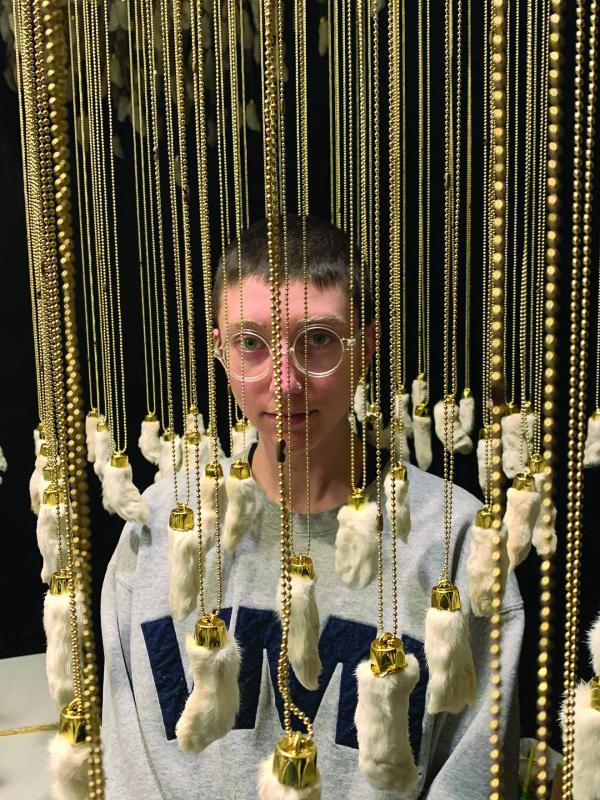March 26, 2020

Georden West, the artist behind “Queer Body in Ecstasy,” a new installation at Dorchester Art Project: “There’s a beauty to it but an awful violence to it, too.” Daniel Sheehan photo
Exhibition awaits reopening at DAP
On Thursday, while much of the country was grappling with the developing coronavirus crisis, filmmaker and media artist Georden West was in the Dorchester Art Project gallery in Fields Corner affixing thousands of white rabbits feet to five-foot long brass chains.
The tedious process was one step in the construction of the central piece of artwork in West’s “Queer Body in Ecstasy” installation, which had been scheduled to be on display from March 14 through April 11 at the DAP gallery until its management decided to close until April 1.
In the piece, the rabbits feet dangle from ball chains affixed to a chicken wire ceiling in a closely measured grid-like pattern to form symmetrical diagonal and horizontal rows meant to be at once aesthetically pleasing and mesmerizing. But constructing the final product meant hours of work: first ordering the materials in bulk, then making sure each length of chain was identical, and, finally, counting squares of chicken wire to make sure the grid was mathematically correct.
“All the length had to be cut, everything had to be measured, so it’s a really labor-intensive piece,” explained West. “But I think it manifests to look simple and elegant.”
With the exhibition, West said, the aim was to explore the way their own queerness is simultaneously presented as a “failure of femininity” and a “tokenized” version of sexuality. “It’s grappling with gender, and how to navigate that both as a sexual person and a person of the world. How do I navigate and rebuild an idea around what it means to be a sexual person as a non-binary person, and what does it mean to also struggle with being sexualized as a queer person?”
West chose rabbits feet and golden brass chains and key rings – items with symbolic weight and spiritual significance – to represent the duality inherent in the struggle. “The materials we used are more or less tokens,” they said. “What does it mean to be tokenized, and how do I bring that conversation into the architecture of the space? It both feels harshly geometric but beautiful...there’s a beauty to it, but an awful violence to it, too.”
Raised Catholic, West said their superstitious tendencies played a role in envisioning the exhibition. Historically, rabbits feet are worn as a good luck charm, or a way to ward off evil. That “grotesque idea of carrying around another thing to ward off something for yourself, something that is not of you that you’ve taken from something else in order to carry throughout the world, I think that kind of reflects what it means to be fetishized in a lot of ways,” said West.
A second installation in the exhibition arranges hundreds of gold key rings, which “elevate commodity to the level of art,” in a “field” pattern on the floor just beyond the lattice of rabbits feet. West’s intention is that the two pieces will complement each other. “I’m interested to see how people will react [to the rabbits feet]. Will they just walk through them? Will they duck under them?...When there’s something arranged on the floor like that, it always seems to create an aura.”
Due to the hiatus at DAP, “Queer Body in Ecstasy” likely won’t be open to the public for at least a few weeks. But the methodical setting up process of the exhibition, amid the COVID chaos evolving outside, seemed to give West a brief respite from reality.


